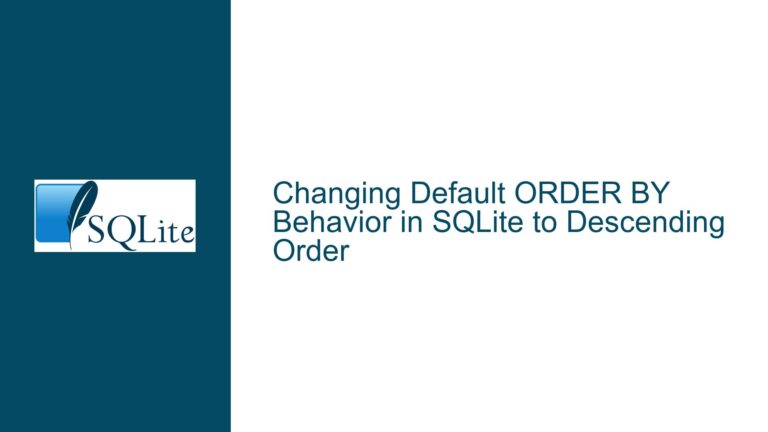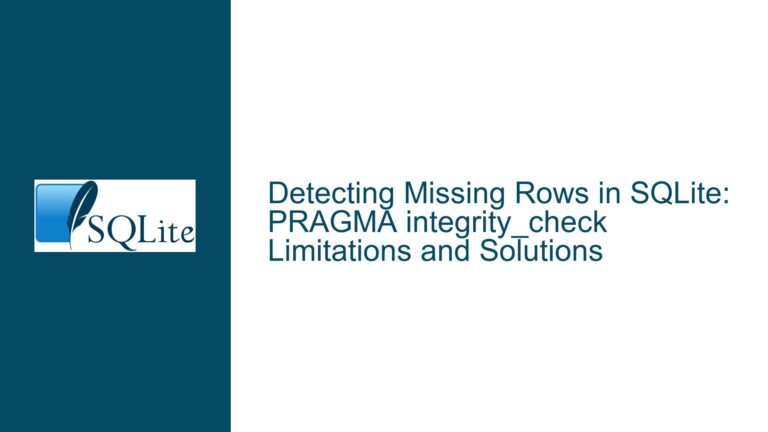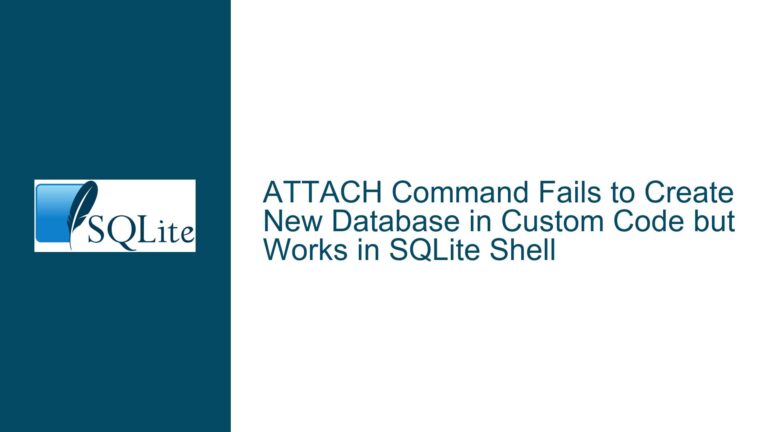Resolving System.EntryPointNotFoundException in SQLite.Interop.dll
Issue Overview: Missing Entry Point in SQLite.Interop.dll
The core issue revolves around a System.EntryPointNotFoundException error, specifically indicating that the entry point SI9dbf9d88aa001ea6 cannot be found in the SQLite.Interop.dll. This error occurs during the initialization of the SQLite connection, specifically when the System.Data.SQLite.SQLite3.StaticIsInitialized() method is invoked. The error message suggests that the SQLite native interop layer is unable to locate a required function within the SQLite.Interop.dll, which is a critical component for the .NET wrapper to communicate with the native SQLite library.
The error manifests in the context of a .NET application using the System.Data.SQLite.Core.NetFramework package, version 1.0.117.0. The application attempts to establish a connection to an SQLite database, but the process fails due to the missing entry point. This issue is particularly problematic because it prevents the application from initializing the SQLite logging subsystem, which is essential for debugging and operational logging.
The SQLite.Interop.dll is a native DLL that acts as a bridge between the managed .NET code and the unmanaged SQLite library. It contains the necessary function exports that the .NET wrapper (System.Data.SQLite.dll) relies on to perform low-level operations. When the entry point is missing, it indicates either a mismatch between the .NET wrapper and the native interop DLL, a corrupted or incomplete installation, or an issue with the runtime environment.
Possible Causes: Mismatch, Corruption, or Runtime Issues
The System.EntryPointNotFoundException error can be attributed to several underlying causes, each of which requires careful consideration to diagnose and resolve effectively.
Mismatch Between .NET Wrapper and Native Interop DLL
One of the most common causes of this error is a version mismatch between the System.Data.SQLite.dll (the .NET wrapper) and the SQLite.Interop.dll (the native interop layer). The .NET wrapper relies on specific function exports from the native DLL, and if the versions are not aligned, the required entry points may not be found. This mismatch can occur if different versions of the SQLite libraries are installed or if the application is referencing an incorrect version of the SQLite.Interop.dll.
For example, if the application is built against version 1.0.117.0 of the System.Data.SQLite.Core.NetFramework package but the SQLite.Interop.dll is from a different version, the function exports may not match, leading to the EntryPointNotFoundException. This issue is particularly prevalent in environments where multiple versions of the SQLite libraries are present, or where the application is deployed without ensuring that all components are correctly aligned.
Corrupted or Incomplete Installation
Another potential cause is a corrupted or incomplete installation of the SQLite libraries. If the SQLite.Interop.dll is missing, incorrectly placed, or corrupted, the .NET wrapper will be unable to locate the required entry points. This can happen if the installation process is interrupted, if files are manually moved or deleted, or if the application is deployed without including all necessary components.
In some cases, the SQLite.Interop.dll may be present but corrupted due to disk errors, network issues during download, or other environmental factors. A corrupted DLL will not function correctly, and the .NET wrapper will fail to locate the required entry points, resulting in the EntryPointNotFoundException.
Runtime Environment Issues
The runtime environment can also play a significant role in this issue. The SQLite.Interop.dll is a native DLL, and its behavior can be influenced by the runtime environment, including the operating system, architecture (x86 vs. x64), and the presence of required dependencies. If the runtime environment is not correctly configured, the native DLL may fail to load or function as expected.
For example, if the application is running on a 64-bit system but the SQLite.Interop.dll is compiled for 32-bit (or vice versa), the DLL will not load correctly, and the .NET wrapper will be unable to locate the required entry points. Similarly, if the runtime environment is missing required dependencies (such as the Visual C++ Redistributable), the native DLL may fail to initialize, leading to the EntryPointNotFoundException.
Troubleshooting Steps, Solutions & Fixes: Ensuring Compatibility and Correct Installation
Resolving the System.EntryPointNotFoundException error requires a systematic approach to identify and address the underlying cause. The following steps provide a comprehensive guide to troubleshooting and resolving this issue.
Step 1: Verify Version Compatibility
The first step is to ensure that the versions of the System.Data.SQLite.dll and SQLite.Interop.dll are compatible. This involves checking the version numbers of both components and ensuring that they match. The version of the System.Data.SQLite.Core.NetFramework package should be consistent with the version of the SQLite.Interop.dll.
To verify the version of the System.Data.SQLite.dll, you can inspect the properties of the DLL in the project references or check the package version in the packages.config or csproj file. The version of the SQLite.Interop.dll can be determined by inspecting the file properties or using a tool such as Dependency Walker to examine the DLL.
If a version mismatch is detected, the solution is to update or reinstall the SQLite libraries to ensure that both components are aligned. This can be done by updating the NuGet package or manually downloading and installing the correct versions of the libraries.
Step 2: Ensure Correct Placement of SQLite.Interop.dll
The SQLite.Interop.dll must be placed in the correct directory for the .NET wrapper to locate it. The DLL should be located in a subdirectory that matches the architecture of the application (e.g., x86 or x64). The directory structure should look like this:
/ApplicationDirectory
/x86
SQLite.Interop.dll
/x64
SQLite.Interop.dll
If the SQLite.Interop.dll is not placed in the correct directory, the .NET wrapper will be unable to locate it, resulting in the EntryPointNotFoundException. To resolve this, ensure that the DLL is placed in the appropriate subdirectory based on the application’s architecture.
Step 3: Check for Corrupted Files
If the SQLite.Interop.dll is corrupted, it will not function correctly, and the .NET wrapper will fail to locate the required entry points. To check for corruption, you can compare the file size and checksum of the DLL with a known good version. If the file is corrupted, the solution is to replace it with a valid version.
You can obtain a valid version of the SQLite.Interop.dll by reinstalling the SQLite libraries from the NuGet package or downloading it from the official SQLite website. After replacing the DLL, rebuild the application and test to ensure that the issue is resolved.
Step 4: Verify Runtime Environment Configuration
The runtime environment must be correctly configured to support the SQLite.Interop.dll. This includes ensuring that the correct architecture (x86 or x64) is targeted and that all required dependencies are installed.
To verify the architecture, check the project settings in Visual Studio and ensure that the target platform matches the architecture of the SQLite.Interop.dll. If the application is targeting Any CPU, consider changing it to a specific architecture (x86 or x64) to avoid potential issues.
Additionally, ensure that the required dependencies, such as the Visual C++ Redistributable, are installed on the system. The SQLite.Interop.dll may depend on these components to function correctly, and their absence can lead to the EntryPointNotFoundException.
Step 5: Rebuild and Redeploy the Application
After addressing the potential causes, rebuild and redeploy the application to ensure that all changes are applied correctly. This includes ensuring that the correct versions of the SQLite libraries are referenced, the SQLite.Interop.dll is placed in the correct directory, and the runtime environment is correctly configured.
During the rebuild process, pay attention to any warnings or errors that may indicate issues with the SQLite libraries. If the build is successful, deploy the application to the target environment and test to ensure that the EntryPointNotFoundException is resolved.
Step 6: Use Dependency Walker for Advanced Diagnostics
If the issue persists, you can use a tool such as Dependency Walker to perform advanced diagnostics on the SQLite.Interop.dll. This tool can help identify missing dependencies, incorrect architecture, or other issues that may be causing the EntryPointNotFoundException.
To use Dependency Walker, open the SQLite.Interop.dll in the tool and examine the list of dependencies. Look for any missing or unresolved dependencies, and ensure that the architecture of the DLL matches the target environment. If issues are identified, address them by installing the required dependencies or correcting the architecture.
Step 7: Consider Alternative SQLite Libraries
If the issue cannot be resolved through the above steps, consider using an alternative SQLite library that may be more compatible with your environment. For example, the Microsoft.Data.Sqlite library is a lightweight alternative to System.Data.SQLite and may provide better compatibility with modern .NET applications.
To switch to Microsoft.Data.Sqlite, remove the System.Data.SQLite.Core.NetFramework package from your project and install the Microsoft.Data.Sqlite package. Update your code to use the new library, and test to ensure that the EntryPointNotFoundException is resolved.
Conclusion
The System.EntryPointNotFoundException error in SQLite.Interop.dll is a complex issue that can arise from version mismatches, corrupted files, or runtime environment issues. By following the troubleshooting steps outlined above, you can systematically identify and address the underlying cause, ensuring that your application can successfully initialize the SQLite connection and avoid this error.






